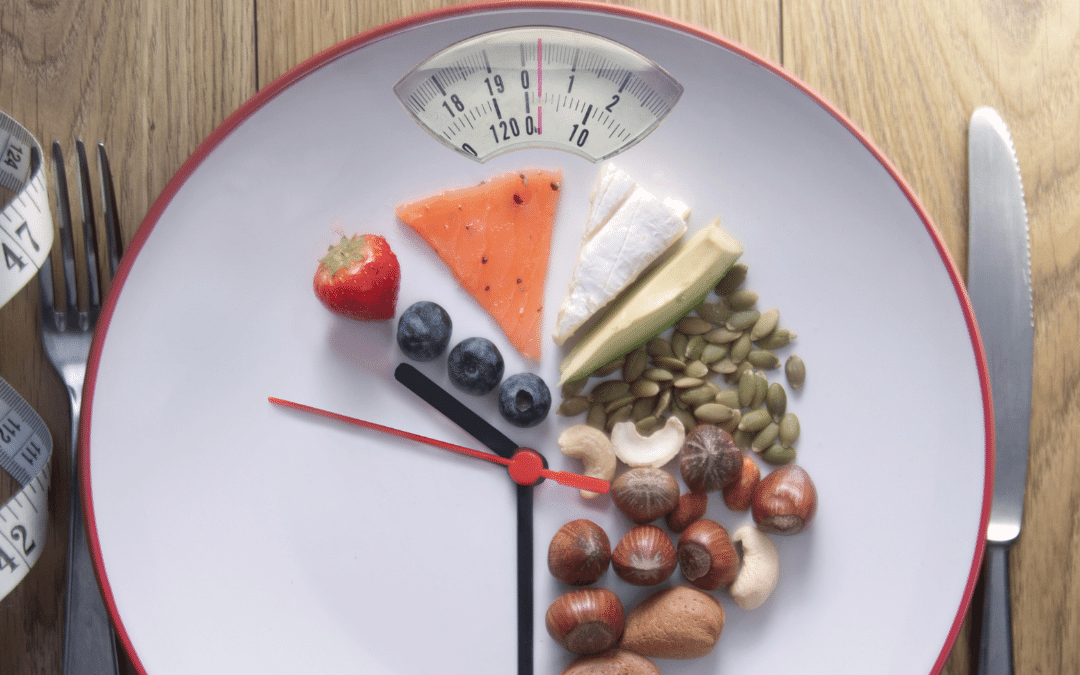Low-carb diets have become very popular over recent years. Many people use a low-carb diet to help them lose weight or maintain a healthy weight, improve energy levels, manage diabetes and much more. There is also a lot of talk about using a low-carb diet to improve fertility. So, what’s the deal? Should you try a low-carb diet to help you get pregnant? Is a low-carb diet safe while trying to conceive? Let’s dive in.
What is a Carb?
To begin, let’s discuss what a carbohydrate is. Carbohydrates are a type of macronutrient, like proteins and fats. Carbs come in the form of fiber, starches and sugars. When food that contains carbs is eaten, the carbs are broken down into glucose (aka sugar) and that glucose enters the blood (blood sugar). When our body senses a rise in blood sugar, insulin is released from the pancreas to help that glucose enter the body’s cells to be used for energy or stored for later use. When we have too much stored glucose (glycogen), the body turns the excess into fat.
Complex and Simple Carbs
Carbs can be found in various amounts in many foods and drinks, however, not all carbohydrates are equal. It is important to first differentiate simple carbs from complex ones.
In general, starches and fibers are classified as complex carbs which take our body longer to digest (or in the case of fiber, don’t get digested at all) resulting in less of a spike in blood sugar. These are found in fruits, vegetables, beans, legumes, whole-grains, nuts and seeds.
On the other hand, simple carbohydrates are quickly digested and absorbed into the bloodstream, resulting in a quick spike in blood sugar levels. Sugars are a type of simple carbohydrate which are found naturally in dairy products, fruits, some vegetables and some grains, but primarily through added sugars and processed foods. This includes most baked goods, breakfast cereals, granola bars, breads, pasta, white rice, candy, sugar-sweetened beverages, condiments, and any foods with added sugars. Added sugar can be sneaky because it goes by many names including cane sugar, corn syrup, molasses, dextrose, fructose, sucrose, galactose, glucose, maltose, maltodextrin, fruit juice concentrate, brown rice syrup, agave, even honey, maple syrup, coconut sugar, but the list seems endless.
It is important to keep in mind that not all foods that contain simple carbs raise your blood sugar to the same level. Since fruits and vegetables contain some fiber, you absorb the sugar more slowly and get a less dramatic rise in blood sugar than if you ate a candy bar with added sugar.
What is a low-carb diet?
Like most topics in nutrition, there is a lot of variability and confusion when it comes to defining a low-carbohydrate diet (LCD). There are many variations of LCDs and they differ by how much restriction they place on total carbohydrate intake. The American Academy of Family Physicians defines LCDs as having less than 20% of calories coming from carbohydrates. That means if you are eating 1800 calories a day, up to 360 calories will come from carbs. That is the equivalent of 90g of carbs. However, in much of the research on LCDs, a low-carb diet can be defined as having an intake of less than 45% of calories coming from carbs.
Comparatively, the ketogenic diet, an extreme version of an LCD, is typically defined as an intake of less than 10% of calories from carbs, or about 20-50g of total carbs daily. The ketogenic diet is a unique diet, and we will not be addressing the nuances in this article. To be clear, for the remainder of this article, an LCD does not include the ketogenic diet.
At the end of the day, an LCD could be any diet with a reduction in the consumption of carbs relative to the average diet. So it is obvious how confusing it can be to truly understand the impact of an LCD when the research is so varied. What’s more is that we know food quality is so important, so it is not merely about the percentage of macronutrients consumed, but the food choices making up the diet, which is hard to control when these diets are being studied.
So why go “low carb”?
Although the variability in the definition of an LCD has complicated the research, an LCD is an effective strategy for weight loss. Carbs are easy for our body to use as energy, so if we lower our carbohydrate intake, our body burns through the carbs quicker and moves on to our stored fat for energy instead. In many people, this will lead to fat loss.
Also, when we lower carbs, we naturally eat more fat and protein to compensate. Both fat and protein are much more filling than carbs, and it is shown that this leads to reduced hunger and less hypoglycemia. This naturally reduces calorie intake, again promoting weight loss, plus high-quality protein and fat are so important for healthy sex hormone production and egg quality.
Another change that is seen when carbs are restricted, is we have less insulin release. Insulin is a storage hormone, and when it is high it is very challenging to burn fat. By reducing insulin there is an improvement in metabolic function leading to increased weight loss. Beyond weight loss, we now understand that chronic elevation in insulin levels may impair egg and sperm quality, as well as impact sex hormone balance.
In the research, when we compare low-fat diets to low-carb diets, the following results are seen in the low-carb group:
- Lower triglyceride levels
- Higher “good” cholesterol
- Similar “bad” cholesterol
- Lower HbA1c (a marker of long-term sugar metabolism)
- Greater weight loss at 3 + 6 months
- At one year, there are no differences in weight loss. But, what’s interesting is that there is a much lower drop-out rate for those on an LCD, likely because of the higher protein intake and appetite suppression. Thus, an LCD diet is easier to stick to long-term.
Can an LCD help you get pregnant?
As always, it depends!
For those who are overweight or obese, a low-carb diet may be a good strategy to lose weight before conceiving. Obesity reduces fertility and is a significant risk factor for complications in pregnancy. Research has found that overweight and obese people with ovaries who lose weight before getting pregnant have increased pregnancy rates, live birth rates, regular menstrual patterns, decreased cancelled IVF cycles, increased number of embryos from IVF and decreased miscarriage risk. For this population, a low-carbohydrate diet may in fact help you get pregnant.
An LCD is also commonly recommended for people with PCOS. High carbohydrate intake and insulin secretion reinforce the metabolic challenges we see with PCOS. When patients with PCOS follow a LCD we see a reduction in BMI (aka weight loss), reduced insulin resistance, improved hormone balance and decreased testosterone levels. A low-carb diet may be one of the most important strategies for getting pregnant with PCOS.
Lastly, it has been shown that people who eat a highly refined diet have a lower chance of conception and are more likely to have impaired fertility. Thus, by making the switch to a low-carbohydrate diet, with a focus on whole foods, it can be assumed that there would be a benefit on fertility. To understand if an LCD may benefit you, speak to your ND or healthcare practitioner.
Is an LCD Safe While Trying to Conceive?
While good-quality, long-term data is lacking, we can make some reasonable assumptions based on human physiology and what we know about nutrition and fertility. In general, a low carbohydrate diet can be safely followed while trying to conceive. However, there are a few important considerations that need to be stated:
Carbohydrate needs vary by individual. Reducing carbohydrate intake to 20% may work really well for some, while others may need to keep their carbs at 45%. You should always work with your ND or practitioner to determine your specific needs while TTC.
Instead of counting carbohydrates, we can make better food choices overall, which tends to naturally lower the amount of carb intake.
Choose nutrient-dense carbs that have fiber and lots of vitamins and minerals. Remember, this includes fruits, vegetables, beans, legumes, whole-grains, nuts and seeds.
Eliminate foods that are refined and highly processed. These foods tend to include high amounts of simple carbs that are not supportive of general health or fertility. Remember this includes foods that contain added sugars (in any form), pastries, granola bars, cereals, breads, pasta, white rice, candy, sugar-sweetened beverages, condiments, and most packages foods.
If reducing carbohydrates, ensure to eat high-quality fats and protein to keep you satiated and protect your long-term health.
Choose healthy fats like avocado, ghee, fatty fish, extra virgin olive oil, coconut oil, nut butters, walnuts, pumpkin seeds, hemp hearts, eggs, and high-fat dairy.
Choose quality protein sources too. When consuming meat, choose organic/grass-fed/antibiotic-free/free-range/hormones-free options if/when accessible to you. Great protein sources include chicken, turkey, beef, lamb, game meats, eggs, fish, and dairy. *For vegans or vegetarians, it can be very hard to get enough protein while remaining low-carb since most of vegan protein sources contain high amounts of carbohydrates too.
Nutrition can be confusing, but it has such a huge impact on fertility! For those looking to boost their fertility, use the general recommendations above. Focus on whole foods and ditch the processed crap without counting carbohydrates! For those with PCOS or needing to lose weight, a true LCD may be a great addition to your treatment plan. No matter what, it is always best to work with someone who can support you through your fertility diet and give you specific recommendations based on your needs. Speak to your ND, or if you don’t have one, book a complimentary 15-minute discovery today.
References:
- https://www.aafp.org/pubs/afp/issues/2006/0601/p1942.html
- https://www.ncbi.nlm.nih.gov/books/NBK537084/
- https://pubmed.ncbi.nlm.nih.gov/25826729/
- https://pubmed.ncbi.nlm.nih.gov/25132280/
- https://www.ncbi.nlm.nih.gov/pmc/articles/PMC8450607/
- https://www.ncbi.nlm.nih.gov/pmc/articles/PMC7045520/
- https://www.ncbi.nlm.nih.gov/pmc/articles/PMC6899277/


